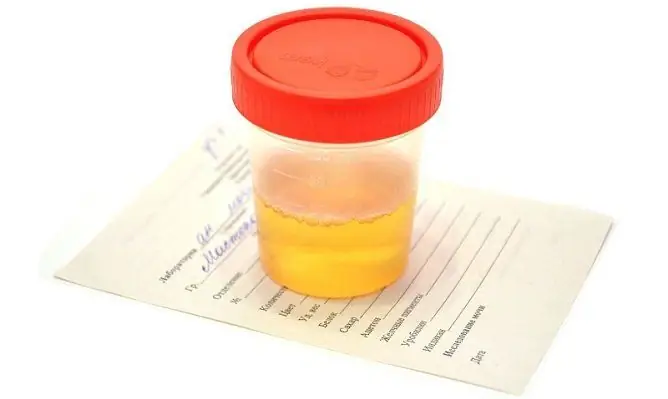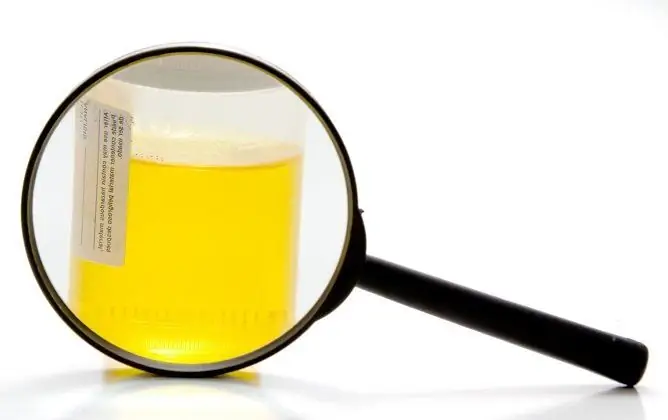- Author Rachel Wainwright [email protected].
- Public 2023-12-15 07:39.
- Last modified 2025-11-02 20:14.
Phytohepatol No. 3
Phytohepatol No. 3: instructions for use and reviews
- 1. Release form and composition
- 2. Pharmacological properties
- 3. Indications for use
- 4. Contraindications
- 5. Method of application and dosage
- 6. Side effects
- 7. Overdose
- 8. Special instructions
- 9. Application during pregnancy and lactation
- 10. Use in childhood
- 11. Drug interactions
- 12. Analogs
- 13. Terms and conditions of storage
- 14. Terms of dispensing from pharmacies
- 15. Reviews
- 16. Price in pharmacies
Latin name: Phytohepatol No. 3
ATX code: A05AX
Active ingredient: calendula medicinal flowers (Calendula officinalis flower) + peppermint leaves (Menthae piperitae folia) + tansy flowers (Tanacetum vulgare flower) + chamomile flowers (Chamomilla officinalis flower) + yarrow grass (Achillea millefolium herba)
Manufacturer: AO Krasnogorskleksredstva (Russia)
Description and photo update: 2020-11-03
Prices in pharmacies: from 36 rubles.
Buy

Phytohepatol No. 3 is a choleretic herbal preparation with antispasmodic and anti-inflammatory effects.
Release form and composition
The dosage form of the drug is a collection of powder: a fragrant mixture of plant materials, consisting of inhomogeneous particles of yellowish-brown color interspersed with white, green, yellow, yellowish-orange and grayish-green; water extract has a bitter taste and light viscosity (2 g each in filter bags, in a cardboard box 10 or 20 filter bags and instructions for the use of Phytohepatol No. 3).
The content of active plant components in 2 g of powder is:
- chamomile flowers: 23%;
- peppermint leaves: 23%;
- calendula officinalis flowers: 23%;
- yarrow grass: 23%;
- tansy flowers: 8%.
Pharmacological properties
Phytohepatol No. 3 (choleretic collection No. 3) is a natural herbal preparation containing a complex of medicinal herbs that provide a combination of three effects at once: choleretic, anti-inflammatory and antispasmodic. The therapeutic effect of the ready-made infusion is due to the properties of the herbal components of the collection and their synergistic interaction.
Medicinal plants - components of Phytohepatol No. 3, composition and pharmacological properties:
- chamomile flowers (Matricaria chamomilla flower): contain flavonoids (apigenin), essential oils (matricin, matricarin, sesquiterpenes), carotenoids, salicylic acid, gums, bitterness, mucus, and other biologically active substances. They have anti-inflammatory, antispasmodic, moderate antimicrobial, diaphoretic, carminative, sedative and analgesic effects, inhibit fermentation processes in the intestine; enhance the secretion of the digestive glands, accelerate the regeneration of the epithelium with ulcers;
- peppermint leaves (Menthae piperitae folia): contain essential oils of menthol and its esters (isovaleric and acetic acids) - up to 2%; cumulate copper, manganese, zinc, selenium. They have a sedative, hypotensive, antispasmodic, anti-sclerotic, analgesic, anti-inflammatory, antiseptic, choleretic, diaphoretic, carminative, moderate laxative effect; eliminate nausea, promote the regulation of the menstrual cycle, increase appetite;
- calendula officinalis flowers (Calendula officinalis flower): contain resin, mucus, flavonoids, carotenoids, bitterness (calenden), malic and salicylic acids, saponin, triterpene glycosides, phytoncides; cumulate copper, molybdenum, zinc, selenium. They have a pronounced anti-inflammatory, bactericidal, antiviral, antimycotic, wound-healing, antispasmodic effect; improve regenerative processes; stimulate the secretory activity of the digestive system; stimulate bile formation / bile secretion; have an antiarrhythmic (slow down the heartbeat) and sedative effect. They have oncoprotective activity, proven high antiviral activity against influenza virus (type A and A2), in vivo demonstrate the ability to suppress herpes simplex viruses;
- Yarrow herb (Achillea millefolium herba): contains essential oils (borneol, azulenes, pinene, thujone, camphor, cineole), organic acids, flavonoids, tannins. They have hemostatic, anti-inflammatory, anti-allergic, bactericidal, wound-healing, hypotensive effect; slow down the heart rate; relieve spasms of the bile ducts, intestines, stomach, urinary tract; tone up the muscles of the uterus. Due to the bitter taste, they stimulate the secretion of the salivary glands, increase bile secretion and the secretion of gastric juice; reduce flatulence;
- tansy flowers (Tanacetum vulgare flower): contain essential oils (camphor, ketone, alpha and beta thujones, borneol, pinene), which are toxic; flavonoid compounds (derivatives of acacetin, luteolin, quercetin, apigenin), tannins, organic acids, ascorbic acid, alkaloids and bitterness, carotenoids; cumulate molybdenum, zinc, selenium. They have antispasmodic, anti-inflammatory, choleretic, diuretic, uterotonic, moderate laxative effects, normalize the menstrual cycle; have antimicrobial, anti-invasive, sedative, analgesic, wound healing, antipyretic, diaphoretic, insecticidal, strong antihypoxant effect; tone up the muscles of the digestive tract, increase its secretion, increase the amplitude of heart contractions and blood pressure.
Indications for use
The use of Phytohepatol No. 3 is indicated in the complex therapy of biliary dyskinesia, chronic non-calculous cholecystitis and chronic hepatitis.
Contraindications
Absolute:
- calculous cholecystitis;
- period of pregnancy;
- breast-feeding;
- hypersensitivity to the components of Phytohepatol.
With caution, only as directed by the attending physician, the infusion of the collection should be used for the treatment of children under the age of 12 years.
Phytohepatol No. 3, instructions for use: method and dosage
Water extract of Phytohepatol No. 3 is taken orally 0.5 hours before meals.
To prepare the infusion, place 2 filter bags (4 g) in an enamel or glass vessel and pour 100 ml of boiling water. Covering the vessel tightly with a lid, let the contents brew for 1/4 hour, periodically pressing the bags with a spoon. Squeezing the sachets tightly and removing them, add boiled water to the infusion until a volume of 100 ml is obtained.
The finished infusion can be stored in a cool place for no more than two days. Shake it before taking it.
Recommended dosage: 100 ml of ready-made infusion 3 times a day.
The duration of the course of treatment is from 14 to 28 days.
Side effects
Against the background of the use of infusion from plants, heartburn and the development of allergic reactions are possible.
Overdose
Symptoms of an overdose of Phytohepatol have not been established.
special instructions
The use of cholagogue infusion should be started after prior consultation with the attending physician.
Influence on the ability to drive vehicles and complex mechanisms
The influence of Phytohepatol on the patient's ability to drive vehicles has not been established.
Application during pregnancy and lactation
The use of the cholagogue collection Phytohepatol No. 3 is contraindicated during pregnancy and lactation.
Pediatric use
Due to the lack of a sufficient number of clinical studies, it is not recommended to use the drug for the treatment of children under the age of 12 without medical supervision.
Drug interactions
Cholagogue infusion Phytohepatol No. 3 is indicated for use in combination with other drugs for the treatment of diseases of the biliary tract.
Analogs
Analogs of Phytohepatol No. 3 are: Choleretic collection No. 3, Ursodez, Ursosan, Grinterol, Urdoksa 500, Exhol, Odeston, Urdoksa, Ursofalk, Berberis-Gomakkord, Gepabene, etc.
Terms and conditions of storage
Keep out of the reach of children.
Store in a place protected from moisture and light.
Shelf life is 2 years.
Terms of dispensing from pharmacies
Available without a prescription.
Reviews about Phytohepatol No. 3
All reviews about Phytohepatol No. 3 are positive. Along with the effectiveness, patients attribute a mild effect, natural composition, good tolerance, and availability to the advantages of a choleretic agent.
Price for Phytohepatol No. 3 in pharmacies
The price for Phytohepatol No. 3 for a package containing 20 filter bags can range from 84 rubles.
Phytohepatol No. 3: prices in online pharmacies
|
Drug name Price Pharmacy |
|
Phytohepatol No. 3 (Choleretic collection No. 3) powder collection 2 g 20 pcs. RUB 36 Buy |
|
Phytohepatol No. 3 (Choleretic collection No. 3) medicinal collection 50 g 1 pc. RUB 70 Buy |

Maria Kulkes Medical journalist About the author
Education: First Moscow State Medical University named after I. M. Sechenov, specialty "General Medicine".
Information about the drug is generalized, provided for informational purposes only and does not replace the official instructions. Self-medication is hazardous to health!






